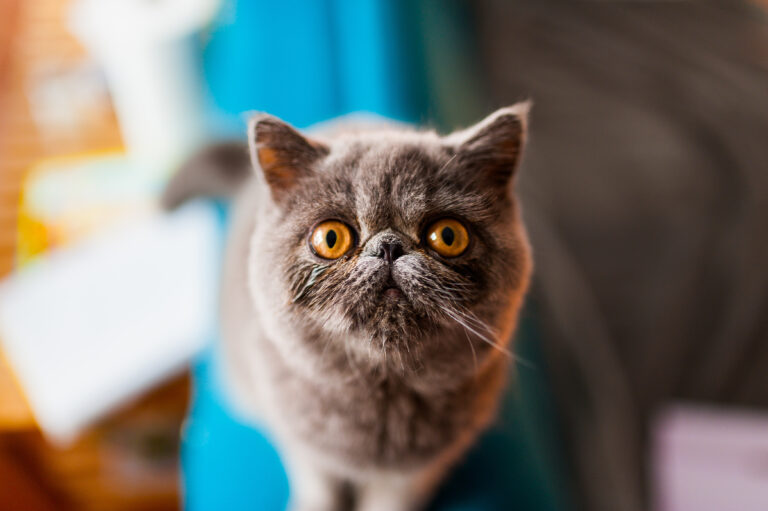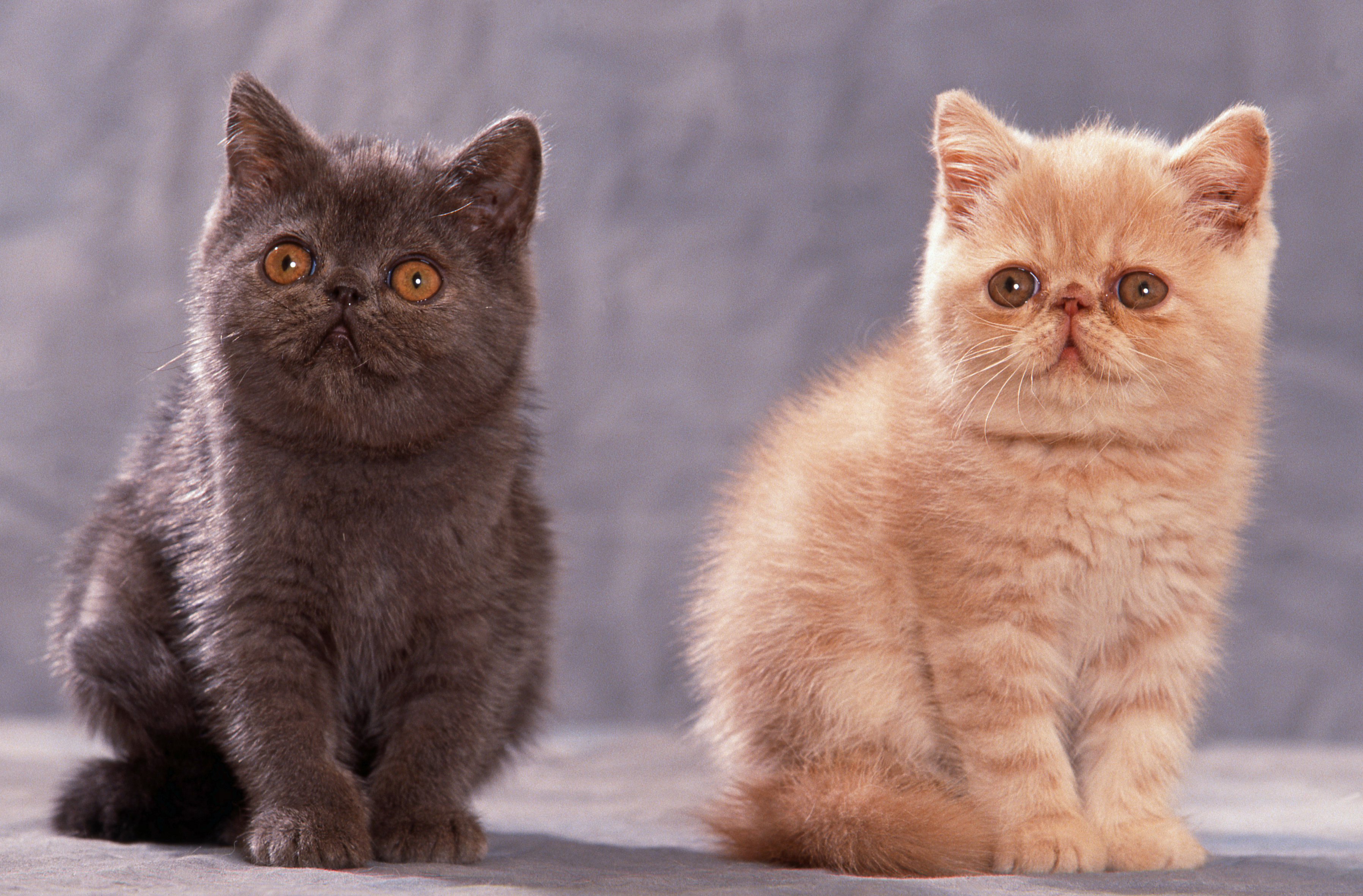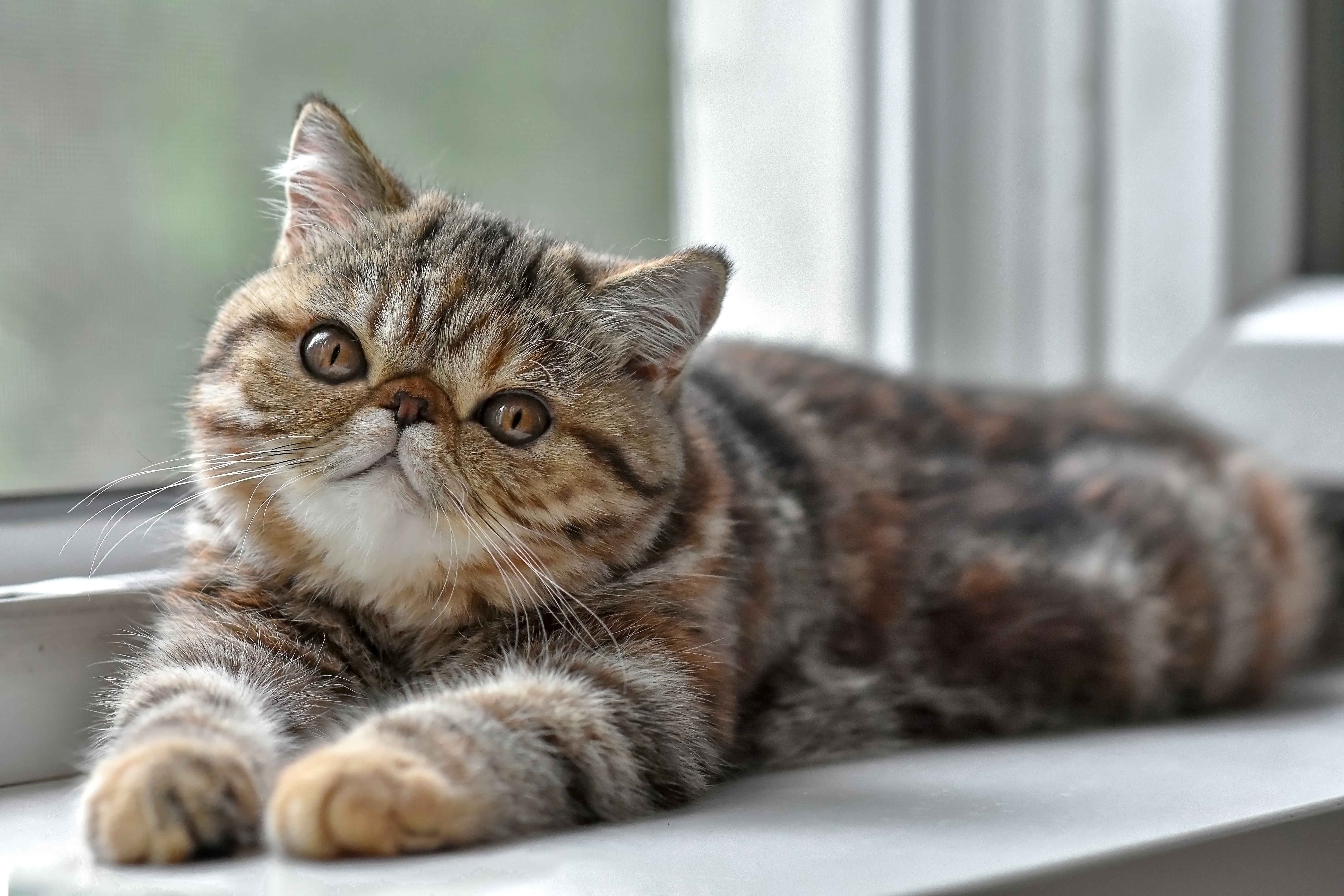Maine Coon
The Maine Coon has now become one of the most popular cat breeds in the world and is enjoying increasing popularity in Ireland, too. This is probably thanks to its authenticity, robustness and excellent character.
Do you love Garfield? Then the Exotic Shorthair is just the right cat for you. After all, it is a recreation of this snuggly, lazy but very loving TV tomcat with short, stocky legs and a large, short-nosed head.

© davide bonaldo / stock.adobe.com
Resulting from the pairing between Persian and British or American Shorthair cats, the Exotic Shorthair is cheekily called the lazy man’s Persian. The Exotic Shorthair possess all the Persian’s positive characteristics but is somewhat lower-maintenance than its long-haired relative thanks to its short fur.
Apart from their fur, there are actually no notable differences between the Exotic Shorthair and the Persian. Hence, the Shorthair is listed as a Persian in some national feline associations. To this day, they share the same standard. In 1983, the Fédération Internationale Féline (FiFe) recognised the Exotic Shorthair as a short-haired version of the Persian.
Scientists assume that the ancestors of Persian cats were already alive in ancient times, so there is no doubt that Persians are one of the oldest pedigree breeds in existence. Based on recent genetic studies, however, it is subject to debate whether they actually come from the Persian city Khorasan, from where the Italian world traveller Pietro della Valle is said to have brought them to Europe. Although the Frenchman Nicolas Claude Fabri de Peiresc is also said to have brought the first long-haired cats from Asia Minor to his homeland in the middle of the 17th century, it could not be proven whether these cats, which were already called Persians, were actually the ancestors of the cat breed we know today. A study published in 2014 by the University of Missouri (US) shows that the present-day Persian breed was in fact a chance breed from specimens of a Russian pet cat.
These elegant long-haired cats achieved worldwide recognition in 1871 when Queen Victoria purchased two blue cats from this breed at an exhibition in London. Hence, the British spearheaded Persian cat breeding for a long time. However, the short-haired Persian came about in the 1950s in the US. American Shorthair breeders paired popular but high-maintenance Persians with their short-haired cats to comply with the request for a Persian cat with a short and low-maintenance coat. The experiment was successful: the offspring of Persians and Shorthairs were just as sociable and friendly as the long-haired Persian – only with short coats. Many Persian breeders started breeding the Exotic Shorthair too and disseminated it further. In 1967, it was recognised as an independent breed in the US.
Nowadays, the Exotic Shorthair can be found in all well-known Persian colours. Along with the most common colours white, black, blue, red, cream, chocolate and lilac, they are found in Chinchilla, with colour points and tiger, blotched and spotted tabby patterns. They have a thick undercoat beneath their dense fur, which makes the top hair stand out from the body and lends them a plushy teddy bear-like look.
Just like Garfield, the related comic character, the Exotic Shorthair generally appears quite relaxed. These medium to large cats are quite stocky with low, squat legs, ending in large round paws to perfectly complete the teddy bear look. Adult Exotic Shorthair males can reach 9kg in weight, whilst females weigh between 4 to 7kg. In keeping with its stocky build, this breed has the large, powerful head typical of Persian cats with a pronounced stop. The huge round skull, flat face and short, broad nose lend them an unmistakeable appearance.
 © CALLALLOO CANDCY / stock.adobe.com
© CALLALLOO CANDCY / stock.adobe.com
Unfortunately exaggerated breeding always led in the past to extremely flat noses that hindered their ability to breath freely and lend to inflammation and complaints in the eyes, nose and throat area. When buying an Exotic Shorthair, you should therefore definitely contact a responsible and reputable breeder who prioritises the breed’s health, loving nature and a natural appearance.
The Exotic Shorthair doesn’t need an exaggerated flat nose to be unmistakable – its unique character takes care of that. It has its own proud nature and is exceptionally people-oriented despite its independence. They love the quiet life with their family and never say no to a cosy nod on the sofa – another thing they have in common with Garfield, the lazy but lovable hero of the series. Their relaxed and even-tempered nature has a wonderfully calming effect on their family, who they are able to skillfully win over with plenty of charm. Although they are less prone to pranks than Garfield, they do understand how to make their family smile and impose their will in a loving way.
Thanks to their calm nature, they are also suited for being kept solely indoors, although they enjoy spending time outdoors too, like almost all cats. However, their forays never take them too far from their home, because after all, a full food bowl and cosy cat blanket await them there. They always seek out close proximity to their family. They are very sociable and compatible cats that aren’t unsettled even by loud and sprightly children. In contrast to many other cat breeds, they feel just as ease in turbulent day-to-day family life as in tranquil single-person households.
The Exotic Shorthair explicitly rejects long periods alone and boredom. They are open-minded when it comes to a playmate in the form of a second cat. These sociable, self-confident cats even get on well with dogs after the usual acclimatisation period.
In keeping with their frugal nature, the Exotic is undemanding when it comes to housing. Even its short fur proves very low-maintenance. Apart from when it moults twice a year, it only needs combing once to twice a week.
It is also undemanding regarding its diet. In order to avoid obesity or other health complaints, however, you should give your cat a species-appropriate diet made up of a high-quality cat food.
Discover our selection of cat food!
 © Светлана Акифьева / stock.adobe.com
© Светлана Акифьева / stock.adobe.com
As is known with the Persian breed, a problem of the Exotic Shorthair is when its nose is bred to be excessively short, which can lead to a series of severe health complaints. Breathing difficulties, watering eyes, problems consuming food and other pains are unfortunately commonplace with peke-faced cats. Another problem is widespread inbreeding amongst the Exotic Shorthair, which can lead to further diseases typical of the breed and a reduced life expectancy.
If you’re interested in an Exotic Shorthair, you should definitely contact a serious breeder and only buy kittens from a healthy pedigree. Make sure that no forebearers feature twice in the family tree in order to rule out inbreeding. The breeder should also have the animals they deploy for breeding tested for widespread hereditary diseases and their kittens vaccinated, dewormed and microchipped. An Exotic Shorthair free of breeding exaggerations has a long life expectancy of 15 years or more. Of course a responsibly bred pedigree Exotic Shorthair comes at a cost (around 1,000 euros), but you this will allow you to save a lot on veterinary costs.
Alternatively, you can also take a look at a nearby animal shelter where many adult cats, including Persians, Exotic Shorthairs or hybrids, are waiting for a new home and a second chance. Ask in the animal home where the cat comes from and whether inbreeding or severe hereditary diseases can be ruled out. The animal keepers at the home will usually be friendly and willingly and sincerely answer your questions about the cats.
Before you head to the next animal shelter or breeder, you should naturally be convinced that the Exotic Shorthair is right for you. You’ll be doing neither yourself nor your cat a favour if you observe after a few months that living together isn’t working as well as you imagined and you have to give up your new furry friend again. Buying a pet should be well thought through. The following questions can help your considerations:
Have you clarified all the questions and all your family members agree on purchasing a cat? You aren’t scared of big cats, enjoy company and are longing for a calming influence in your day-to-day life? With its infectious conviviality and serenity, the Exotic Shorthair is guaranteed to enrich you and your family.
The Maine Coon has now become one of the most popular cat breeds in the world and is enjoying increasing popularity in Ireland, too. This is probably thanks to its authenticity, robustness and excellent character.
Neva Masquerade – a mysterious name for a mysterious thing of beauty! The Neva Masquerade is the point variation on the Siberian cat and shares many characteristics with this breed.